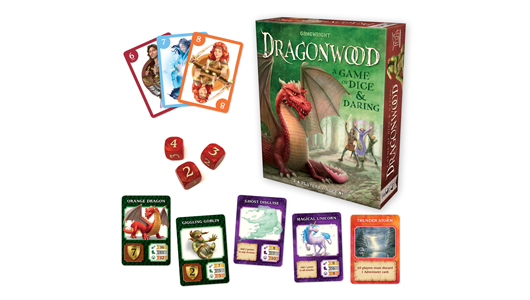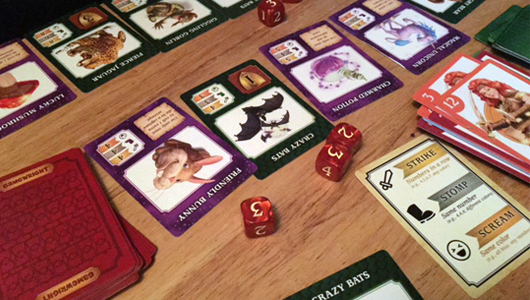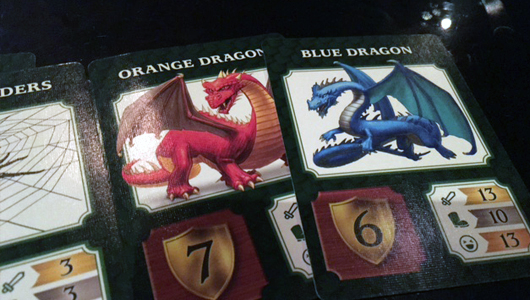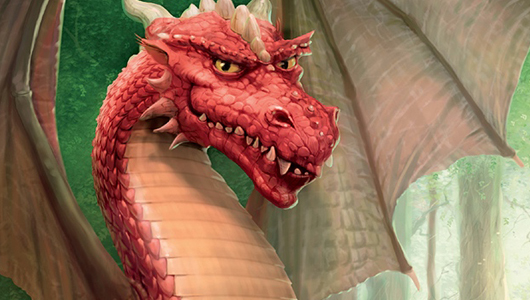Magical forests are known to be inhabited by Trolls, Goblins, Unicorns and, in case of Dragonwood, even Dragons. It is also known that heroes go into magical forests to defeat monsters and prevent them from terrorising nearby villages. The success of these quests depend on preparation, skill and, of course, a little bit of luck. So if all of this sounds like a job for you, than Dragonwood could be your type of game.
• Designer: Darren Kisgen
• Publisher: Gamewright
• Number of Players: 2-4
• Playing Time: 20 mins

Dragonwood is a risk management dice and card game for up to 4 people. Players draw different adventure cards from their hand to try to defeat the monsters of Dragonwood. After defeating a monster, the player is rewarded with victory points corresponding to its difficulty, Dragons being the most challenging ones to beat. The player with the most points wins.
Various power-ups can be acquired to aid players, and there are various events that get resolved as soon as the card is drawn from the main deck. The main mechanic of the game is the method of attacking monsters – to defeat a monster you can strike them, stomp them or even scream at them (to scare them away, presumably), by playing cards from your hand. In order to perform a strike attack, the player has to draw cards with consecutive numbers. To stomp them: play cards with the same number. Finally, to scream at them: cards of the same colour. The amount of cards each player lays down from their hand corresponds to the number of dice that they get that turn. The dice roll is what determines whether the player has defeated the monster or not.

This is where the risk management element of the game comes along. Players must decide whether to be safe and play a number of cards that will guarantee them victory over a monster. Or they could risk it by playing a minimum number of cards, hoping for a lucky roll. Also every monster has different stats for various attacks, making them either more susceptible to scream or stomping or striking, which could also be used to the player’s advantage.
With rules and main mechanics of the game covered, I believe, it is safe to say, that Dragonwood is really straightforward to play and would be very easy to pick up for almost anyone, whether a young board gamer or someone who usually doesn’t play games. The way the game plays is also very light. The turns play quite fast and players don’t have to intensely concentrate on the game all the time, making this a great game for play as a background to socialising.

Of course, the other side of coin of this is that in the game itself there is very little player interaction. Beyond checking once in a while how many victory points each player has, there is very little players have to pay attention to. Dragonwood is a game where you make your turn and then can easily ignore the game until it is your turn is up again. Even event cards, that are applied to every player, don’t do much to allow players interact with each other while playing. Another downside of this, is that the game’s pace is on the same level throughout. There isn’t a single big moment in the game; that makes every player around the table either really excited, cautious, suspenseful, or any kind of heightened emotion. Think of scoreboard resolution phase of Blood Bowl Team Manager Card Game, or giving a mandatory quest in Lords of Waterdeep or the reveal of the traitor in The Betrayal At House on a Hill as just some of the examples of where the game changes pace and makes everyone pay attention. Even in Gamewright’s another game, Sushi Go! when players reveal what sushi cards they have chosen is that moment. Dragonwood is just one steady line of the unchanging sameness throughout, and even the reveal of dragon cards doesn’t change that.

However, I suspect that the feeling of sameness mostly applied to all adult games, because for kids there would be a lot excitement in the dice roll itself and seeing if the monster has been defeated. In fact, I think Dragonwood teaches and hones a lot of skills that are really beneficial for young gamers. For example, counting and basics of the probability. But also thinking and deliberating how many cards need to be played to certainly defeat monsters versus playing less or more cards, based on the monsters strength. In this sense, I think Dragonwood is a more successful children’s game, which adults can equally enjoy with them, rather than a game for the ‘hardcore’ side of the board game community. And that is not at all a bad thing!
I also enjoy the illustration in Dragonwood. It gives me a feel of illustrations taken from the old fairy tales and story books. However, what brings the overall look of the game down is how it is graphically presented with chunky frames and its domineering layout. They make it look dated and overshadow the beautiful illustrations themselves.
Dragonwood is a really enjoyable game, that has a very little barrier to access to board gamers new, or experienced, young or old. The rules are really easy to pick up or to explain, and I can see it being played a lot during big board game nights and events. It is also a really great game to play with younger board gamers, as a lot of skills needed to play the game, are really vital skills to pick up and train. However, this straightforwardness and simplicity also has its disadvantages, and won’t keep attention of those us who are looking new and interactive game mechanics for long. Nonetheless, I am glad to have this game in my collection.

Darren
Thanks for the review! I am glad you enjoyed the game. I generally agree with your comments about interaction. I debated for some time including cards that would lead to more direct interaction (at one time I had a “Sabotage” card in the game), but in the end I decided against it because the primary audience for the game is families, and at least in my experience, kids are sometimes not wild about direct attacks (and even couples and friends sometimes prefer a game that doesn’t involve major direct interaction). I realize that is not for everyone, so I am glad you make that element of the game clear, so people are not disappointed if that is what they want. Having said all of that, the game is certainly not solitary, as you have to be aware of other players grabbing enhancements, potentially going for small point cards for the 3 point bonus, possibly taking a high point card before you get a chance to, closing out the game with a dragon attack, etc. But your overall point is fair. Thanks again!